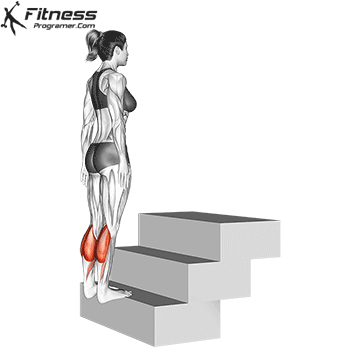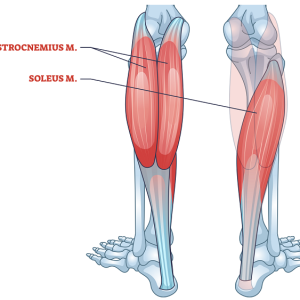Overview
The standing calf raise (bodyweight) is a simple yet effective isolation exercise primarily targeting the calf muscles, specifically the gastrocnemius and soleus. Performing the exercise using only bodyweight makes it accessible for all fitness levels, convenient for home workouts, warm-ups, or as part of general conditioning.
How to Perform Standing Calf Raise (Bodyweight)

Starting Position: Stand upright with feet hip-width apart, maintaining good posture with shoulders back, chest open, and core engaged.
Foot and Body Alignment: Place your toes flat on the end of a high platform and distribute your weight evenly across both legs.
Lift Movement: Slowly rise onto the balls of your feet, lifting heels off the ground as high as comfortably possible, contracting the calves fully.
Controlled Lowering: Gently lower your heels back to the floor, maintaining control throughout the movement.
Repeat: Perform 15–25 repetitions per set, emphasizing controlled and deliberate movements.
Tips for Proper Form:
Maintain a straight posture, avoiding forward lean or backward sway.
Perform movements smoothly and slowly to maximize muscle engagement.
Hold at the top briefly to fully engage calf muscles.
Keep knees slightly bent to reduce joint stress.
Common Mistakes :
Rapid Movement: Quickly bouncing or using momentum reduces muscular activation and can lead to injury.
Limited Range of Motion: Not fully rising onto the toes limits calf engagement.
Incorrect Posture: Leaning forward or backward places unnecessary strain on joints and reduces effectiveness.
Benefits of the Bodyweight Standing Calf Raise
Strengthens and Defines Calf Muscles: Effectively targets gastrocnemius and soleus, enhancing calf strength, definition, and muscle tone.
Improves Ankle Stability and Mobility: Regular performance strengthens ankle stabilizers, reducing injury risk and enhancing overall lower-body functionality.
Accessible and Equipment-Free: Convenient for home workouts, warm-ups, or traveling, as no equipment or gym access is necessary.
Enhances Lower-Leg Circulation: Stimulates blood flow in the lower extremities, aiding muscle recovery and reducing leg fatigue.
Supports Athletic Performance: Builds calf strength and endurance crucial for sports requiring jumping, sprinting, or rapid directional changes.
How to Incorporate Into Your Routine
For Beginners: Begin with 2–3 sets of 12–15 reps, focusing on control and technique.
For Muscle Growth (Hypertrophy): Increase to 3–4 sets of 15–20 reps, emphasizing slow, deliberate movement and full contractions at the top.
For Endurance and Conditioning: Perform higher repetitions (20–30 reps per set) for 3–4 sets, integrating brief rest intervals (30–60 seconds).
For Rehabilitation or Balance Training: Include regularly with moderate repetitions (15–20 reps) to strengthen calves and improve lower-body stability.
For Functional Training or Warm-Up: Execute 1–2 sets of 15–20 reps as part of warm-up routines before leg-intensive workouts or running sessions.
Muscles Worked

Frequently Asked Questions (FAQs)
Can standing calf raises be effective without added weight?
Yes, bodyweight calf raises are effective for developing endurance, muscle tone, and improving stability, particularly with high repetitions.
How often should I perform bodyweight standing calf raises?
Incorporate this exercise into your routine 2–3 times weekly for optimal calf strength and endurance.
Are calf raises beneficial for runners?
Yes, strengthening the calves significantly improves running performance, reduces injury risk, and increases endurance.
How can I increase difficulty without equipment?
Perform the exercise on a step or raised surface to increase range of motion and muscle activation, or do single-leg variations.
Can calf raises help prevent lower-leg injuries?
Regularly performing calf raises strengthens muscles and tendons around the ankle joint, effectively reducing lower-leg injury risk.
